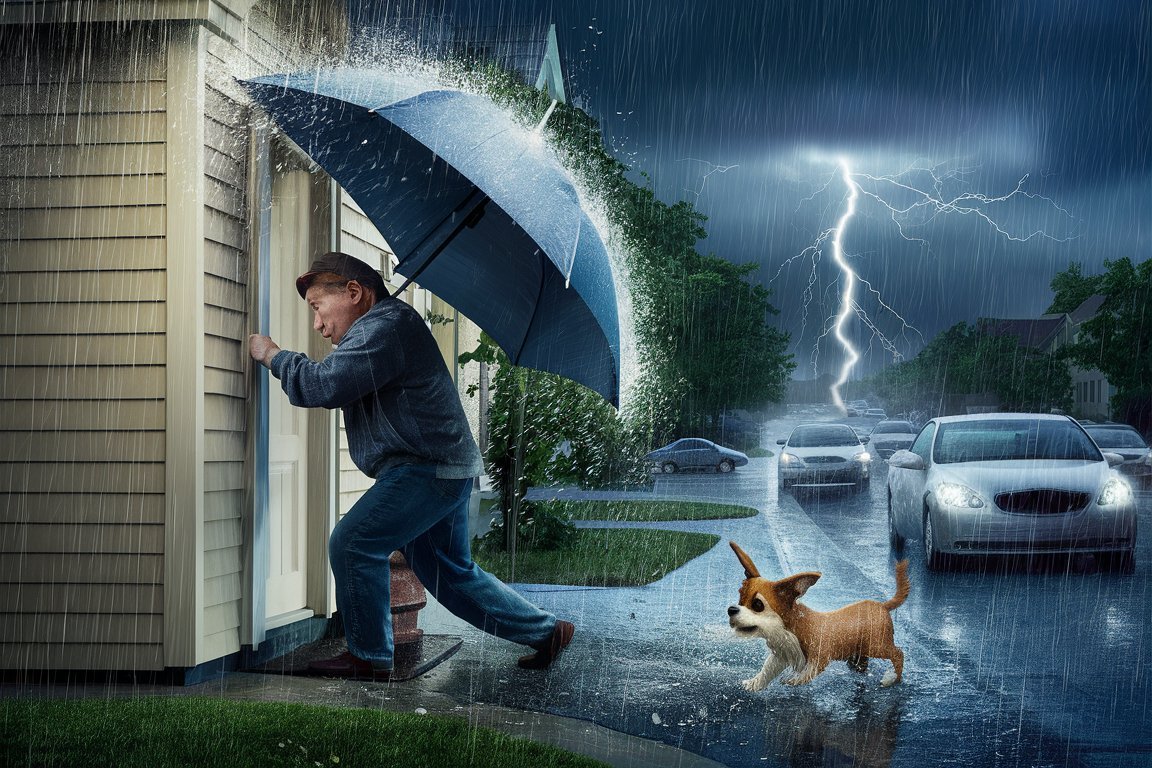As an expert on dogs, I can provide insights into various aspects of canine behavior, health, and training. From understanding why dogs scratch walls to addressing anxiety during thunderstorms,
I offer strategies and solutions tailored to enhance your dog’s well-being. Whether you’re dealing with behavioral issues or seeking to optimize your dog’s care, my expertise can guide you in creating a positive and enriching environment for your furry companion.
How to Protect Your Walls from Dogs During a Storm
When the storm clouds gather and the winds begin to howl, it’s not just the noise that can rattle your nerves. Dogs often become anxious during storms, and that anxiety can lead to behaviors that damage your home. From scratching at the walls to chewing on corners, a frightened dog can wreak havoc. But don’t worry! With a few practical steps, you can protect your walls and keep your dog safe and calm during a storm.
Understanding Why Dogs Get Anxious During Storms
Before we dive into the solutions, it’s important to understand why your dog might act out during a storm. Dogs have an acute sense of hearing, and the loud noises, changes in barometric pressure, and even the smell of rain can trigger fear. This fear might manifest as barking, pacing, or seeking shelter, often leading them to scratch or bite walls as they try to “escape” the storm.
One dog owner I know had a golden retriever named Max. Every time a storm rolled in, Max would start scratching at the walls in the living room, leaving deep gouges in the paint and drywall. Max’s owner tried everything, from playing soothing music to giving him treats, but nothing worked until he took some serious measures to protect both Max and the walls.
Step 1: Create a Safe Space
The first step in protecting your walls is to create a safe space for your dog. This can be a quiet room, a cozy crate, or a dog bed placed in a corner where your dog feels secure.
Steps to create a safe space:
- Choose a Quiet Room: Select a room away from windows, where the noise and flashes of lightning are less noticeable.
- Add Comfort Items: Place your dog’s favorite blanket, toys, and perhaps an item of your clothing that smells like you. This can help calm them.
- Use White Noise: A fan or a white noise machine can help drown out the sounds of the storm.
- Crate Training: If your dog is comfortable in a crate, this can be an excellent safe space. Covering the crate with a blanket can also make it feel more secure.
For Max, his owner decided to turn a small bathroom into his storm haven. With soft lighting, a comfy bed, and his favorite chew toys, Max began to feel more secure. When a storm hit, he would retreat there instead of attacking the walls.
Step 2: Protect the Walls
Even with a safe space, some dogs may still feel the urge to scratch or chew on walls. Here’s how you can protect your walls:
Use Pet-Safe Wall Barriers
One effective method is to use pet-safe barriers on the walls. These barriers can be physical, such as Plexiglas sheets, or chemical, like pet-repellent sprays.
- Plexiglas Sheets: Attach clear Plexiglas panels to the lower portion of your walls. They’re easy to clean, and your dog can’t scratch through them.
- Pet-Repellent Spray: Some sprays are designed to deter dogs from chewing or scratching. Just make sure they are safe and non-toxic.
Max’s owner chose to install Plexiglas on the walls in his living room. Not only did it protect the walls, but it also made cleaning up after Max a breeze.
Apply Bitter Spray to Baseboards
If your dog likes to chew on baseboards, a bitter spray might do the trick. These sprays have a taste that dogs dislike, discouraging them from biting.
How to use bitter spray:
- Test First: Before applying it all over, test a small area to make sure it doesn’t damage your walls.
- Apply Generously: Spray the baseboards and any areas where your dog tends to chew or scratch.
- Reapply as Needed: The spray might wear off over time, so you may need to reapply it during extended storms.
Max’s owner found that a combination of Plexiglas and bitter spray kept Max from damaging the walls, even during the worst storms.
Step 3: Keep Your Dog Calm
Keeping your dog calm during a storm is crucial to preventing damage. Here are some techniques to help soothe your dog:
Behavioral Training
Behavioral training can help your dog remain calm during a storm. Training your dog to associate storms with positive experiences can make a big difference.
Training Tips:
- Desensitization: Play recordings of storm sounds at a low volume while giving your dog treats. Gradually increase the volume over time.
- Counterconditioning: Pair the sound of thunder with something your dog loves, like a favorite treat or toy, to change their emotional response.
- Obedience Training: Basic commands like “sit” and “stay” can help redirect your dog’s focus away from the storm.
Max’s owner worked with a trainer to desensitize Max to storm sounds. Over time, Max became less anxious and more relaxed when storms rolled in.
Calming Products
There are many products designed to calm anxious dogs during storms:
- Thundershirts: These snug vests apply gentle pressure to calm your dog, much like swaddling a baby.
- Calming Chews: Made with natural ingredients, these chews can help reduce anxiety.
- Aromatherapy: Diffusers with calming scents like lavender can help create a soothing environment.
For Max, a Thundershirt and some calming chews worked wonders. His owner noticed a significant decrease in his anxiety during storms.
Step 4: Monitor and Adjust
Finally, it’s important to monitor your dog’s behavior and adjust your approach as needed. Not every solution works for every dog, so you may need to try different combinations of strategies.
- Observe: Keep an eye on how your dog reacts to the steps you’ve implemented. If something isn’t working, don’t be afraid to try something else.
- Consult a Vet: If your dog’s anxiety is severe, consult with your vet. They may recommend anti-anxiety medication or other treatments.
- Be Patient: It may take time for your dog to adjust to new routines and products. Patience and consistency are key.
Max’s owner found that with a combination of a safe space, wall protection, and calming products, Max was finally able to weather storms without damaging the house—or himself.
Conclusion: Protecting Your Walls and Your Dog
Protecting your walls from your dog during a storm isn’t just about preventing damage; it’s about creating a safe and calming environment for your furry friend. By understanding your dog’s anxiety, providing a safe space, and using the right products, you can ensure that both your home and your dog remain unharmed when the weather turns rough.
If you’re ready to take action, consider investing in some of the products mentioned above, like Plexiglas wall barriers, bitter spray, and calming aids. Not only will you be protecting your home, but you’ll also be helping your dog feel more secure during stressful times. And that’s something worth doing.
How do you deal with a dog in a thunderstorm?
How to Help Your Dog During a Thunderstorm:
1. Create a Safe Space: Set up a cozy, quiet room or crate where your dog feels secure.
2. Stay Calm: Your calm behavior reassures your dog.
3. Provide Comfort: Cuddle your dog if they seek it, or use an anxiety wrap like a Thundershirt.
4. Mask the Noise: Use white noise, music, or TV to drown out thunder.
5. Distract: Offer toys, treats, or play games to divert their attention.
6. Consult a Vet: For severe anxiety, ask your vet about calming products or medications.
7. Stay Close: Your presence can help them feel safe.
Why do dogs shake during thunderstorms?
Dogs shake during thunderstorms because the loud noise, changes in pressure, and static electricity make them anxious and fearful. Shaking is their natural response to these overwhelming sensations.
Why do dogs shake during thunderstorms?
Dogs shake during thunderstorms due to anxiety and fear triggered by the loud noise, changes in atmospheric pressure, and static electricity, all of which can be overwhelming for them.
How to stop a dog from scratching walls?
To stop a dog from scratching walls:
1. Identify the Cause: Determine if your dog is scratching due to anxiety, boredom, or trying to reach something.
2. Provide Alternatives: Offer scratching posts, toys, or chew items to redirect their behavior.
3. Exercise and Mental Stimulation: Ensure your dog gets enough physical activity and mental engagement to reduce boredom.
4. Nail Trimming: Keep your dog’s nails trimmed to minimize damage and discomfort.
5. Use Deterrents: Apply a safe, pet-friendly spray deterrent to the walls to discourage scratching.
6. Behavioral Training: Reward good behavior and gently correct the scratching habit using positive reinforcement.


One Reply to “How to Protect walls from Dog during Storm”